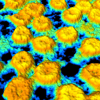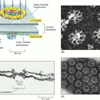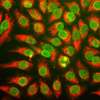Nuclear Pores
Function
General Intro: The Nuclear double membrane contains many
pores used for transport. Each pre is filled by a complex structure
called a "nuclear pore complex" (or NPC) which regulates transport.
Resources:
NPD:
Nuclear Protein Database - The NPD page on the nuclear pore
complex.
Molecular
Expression: Nuclear Pores - An illustrated NPD article from
the FSA Molecular Expression website.
Animated
NPC - A site with computer generated animations of the NPC (illustrations
from the same site can be found here).
Nuclear
Pore Complexes - A nicely illustrated article on the NPC created
by the Dunn Group at the University of Kansas.
Labelled
Images - Several EM images labelled to show individual structures.
(this site requires Java, as well as sound since the labels are audio
rather than text)
Wikipedia Nuclear
Pore Entry - A good overview of information on nuclear pores,
complete with academic sitations and some very nice diagrams. Still,
bear in mind that this is a Wikipedia article, and ultimately isn't
concidered an academically reliable source.
Nuclear
Pore Complex: Structure - Part of an article on the nuclear
envelope with a nice section on the pore complex, pictures, and details
on techniques for imaging the NPC.
Review Article
on the NPC - A brief 2001 review article giving the salient
facts on the NPC and a complete bibliography.
Review
Article on the NPC - A much longer and more thorough review
article on the NPC from 1995.
Images
| A flourescence image of human HeLa cells which have been stained so that the NPC showes up in green. (image and description provided by Encor Biotechnology Inc.) | |
 |
A roughly 600x600 area of the nuclear envelope from an Xenopus laevis oocyte pictured with an atomic force microscope. The NPCs are the raised yellow structures, while the membrane bellow is primarily dark blue. (image and description provided by Prof. Dr. Hans Oberleithner) |
 |
Multiple images of EMs and NPCs juxtaposed with a diagram. (image taken from Molecular Biology of the Cell website) |
